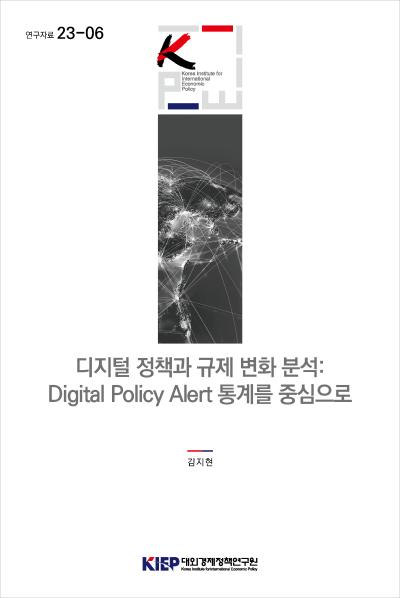Policy Reference
PUBLISH
Policy Reference
To list

Analysis on Digital Policy and Regulations: Based on the Digital Policy Alert Database
E-trade, Electronic commerce
Author Ji Hyeon Kim Series 23-06 Language Korean Date 2023.12.11
Digital policies and regulations are changing rapidly in advanced and major emerging economies. Based on the newly built Digital Policy Alert data, we found 3,876 changes in digital policies and regulations in major countries such as US, EU, China, and India. This is the result of governments’ efforts to embrace the digital age and create a fair and stable digital economy. However, we do not have an accurate understanding of digital policies and regulations’ content around the world. This report aims to provide policy implications for our government’s policy making by objectively analyzing the international trends and status of digital policies and regulations and reducing uncertainty about foreign countries.
Digital trade, which is the trade of goods and services through digital means, has increased worldwide due to the development of digital technology. It can be divided into Business-to-Customer(B2C) and Business-to-Business(B2B) trade. By 2023 B2C trade is expected to reach $6 trillion and B2B trade $24.4 trillion. Asia, in particular, accounts for a large share of digital trade, accounting for more than 50% of the world’s B2C trade and on average 78% of B2B trade in 2022. Korea’s digital trade in goods is also expanding, and the proportion of its exports to China and Japan is decreasing while that to Europe is increasing.
According to existing data, such as that from the OECD and EUI, the level of restrictions on digital services trade around the world is generally increasing. If we look at the regulatory environment of digital trade more broadly, there are many restrictive measures, but the level of restriction is not very high. Specifically, the level of openness in e-commerce and intellectual property rights have increased. On the other hand, the level of restriction in infrastructure and connectivity, or data is the highest. The level of restriction in other areas, which includes online advertising ban, local presence requirements, is also increasing. By region, Europe and North America have the most open regulatory environment, while Central Asia and South Asia have the most restrictive regulatory environment. East Asia-Pacific’s regulatory environment is more restrictive than the global average.
By country, open economies such as Canada, US, Australia, or small countries such as Dominican Republic and Costa Rica, have lower levels of restriction on digital services trade. In contrast, relatively closed emerging economies such as Kazakhstan, Russia, Saudi Arabia, and India have higher levels of restriction on digital services trade. China, Russia, India have more restrictive measures on data transfer, and local data storage and processing than other major countries, and they also take discriminatory measures on communications business licenses and e-commerce. US is the most open to data transfer, while Europe and Japan transfer data conditionally.
According to the Digital Policy Alert, data governance and competition account for the largest share of digital policy and regulatory changes worldwide. The main policy instruments for data governance are data protection, cybersecurity, cross-border data flows, and for competition, unilateral conduct regulation, merger review. Recently, the proportion of other business conditions, and registration and licensing have increased. Their instruments, algorithm design and technical standards for other business conditions, product or service licensing for registration and licensing have became increasingly important. In the policy area of content, changes have increased in user speech rights. In international trade, we see changes in measures such as bilateral and regional agreements and export/import bans. Foreign direct investment and tax are also changing actively.
The top 10 countries with the most digital policy changes are US, EU, UK, China, India, Australia, Korea, Japan, Russia, and Canada. Their digital policy changes focus on personal information and information protection, and they also have policies for emerging industries such as AI and crypto assets. Notably, US has more regulations under discussion than adopted or implemented. China and India have relatively more data localization requirements than other countries. Russia has many content-related policy changes, while China and US are active in the registration and licensing area.
Other business conditions, registration and licensing are policy areas which have recently gained attention in digital policy and regulation. Among them, algorithm design and technical standards (other business conditions), product or service authorization (licensing and registration) are mainly used as policy tools. The aforementioned top 10 countries are seeking cooperation for standardization work concerning new industries such as AI. When it comes to crypto assets, countries adopt rather opposite policies depending on their perspective.
Korea’s level of regulatory restriction on digital services trade is lower than that of East Asia-Pacific, but it is higher than the global average. Korea’s digital services trade regulations are becoming more similar to Germany and less similar to China. In terms of digital policies and regulations, Korea is discussing various digital policies such as data protection, unilateral conduct regulation etc.
In conclusion, first, Korea follows the international trend in terms of policy changes in areas such as data governance, other business conditions, competition, but more active discussion on content is needed. Second, international standardization discussions are actively taking place. Korea should be more strategic and base its discussion on the cooperation status of other countries. Third, considering Digital Policy Alert with other existing data will provide a comprehensive picture of digital policies and regulations. Finally, collecting digital policies and regulations by ourselves would be a first step to respond more accurately to changes in digital policy regulation.
Sales Info
| Quantity/Size | 114 |
|---|---|
| Sale Price | 7 $ |
 공공저작물 자유이용허락 표시기준 (공공누리, KOGL) 제4유형
공공저작물 자유이용허락 표시기준 (공공누리, KOGL) 제4유형
대외경제정책연구원의 본 공공저작물은 "공공누리 제4유형 : 출처표시 + 상업적 금지 + 변경금지” 조건에 따라 이용할 수 있습니다. 저작권정책 참조
